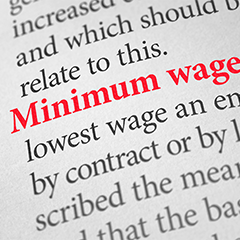The Current State of Minimum Wage Laws
July 20, 2016 | Business Plans, IRS Regulation, Tax Planning
 Since 1991, the $7.25 per hour federal minimum wage has been in place. The inflation-adjusted wage would have to be $12.68 to have the same purchasing power today, according to the CPI Inflation Calculator from the U.S. Bureau of Labor Statistics. President Obama has been supporting an increase in the federal minimum wage to $12 per hour for the past three years.
Since 1991, the $7.25 per hour federal minimum wage has been in place. The inflation-adjusted wage would have to be $12.68 to have the same purchasing power today, according to the CPI Inflation Calculator from the U.S. Bureau of Labor Statistics. President Obama has been supporting an increase in the federal minimum wage to $12 per hour for the past three years.
Pending legislation — the “Raise the Wage Act,” proposed by U.S. Sen. Patty Murray (D-Wash) and supported by presidential candidate Hillary Clinton — would make that happen by 2020. Secretary Clinton’s Democratic rival, Sen. Bernie Sanders, is calling for a prompt increase to $15 per hour.
Today, $2.13 is the federal hourly minimum wage for tipped employees, so long as the tipped employee’s wage plus tips works out to at least $7.25 per hour (this is known as the “tip credit against minimum wage”). Thus, to satisfy the federal requirement, the employee’s average hourly tips must be at least $5.12. Under the federal standard, “tipped employees” are generally defined as those who earn at least $30 per month in tips, a very low threshold.
Higher Standard Prevails
The federal standard prevails when state minimum wage rates are less generous than the federal government’s rate, as they are in Georgia and Wyoming. And when state minimum wage rates exceed those of the federal government, as they do in 30 states, the state law prevails. So, too, do minimum wages established by municipal and county governments. Here are the 30 states:
Alaska, Arizona, Arkansas, California, Colorado, Connecticut, Delaware, Illinois, Iowa, Maine, Maryland, Massachusetts, Michigan, Minnesota, Missouri, Montana, Nevada, New Hampshire, New York, North Dakota, Ohio, Oklahoma, Oregon, Pennsylvania, Rhode Island, South Dakota, Vermont, Washington, West Virginia, Wisconsin.
And in these seven states, tips cannot be used to offset the state’s minimum wage:
Alaska, California, Minnesota, Montana, Nevada, Oregon and Washington.
Minimum wage increase plans at the state level were adopted by California and New York in early April. California’s current $10 hourly minimum wage will rise in steps to $15 per hour by 2022. In California, this also applies to tipped employees, as tips don’t offset minimum wages there. Employers with 25 or fewer workers will have another year to meet that standard.
Within three years, New York’s current $9 per hour minimum wage will rise to $15 in New York City, and be phased in at lower levels throughout the rest of the state based on a formula tied to economic indicators, including inflation.
Although supporters of an increase in the federal minimum wage in Congress have been unsuccessful in persuading enough of their colleagues to make it a reality, President Obama in 2014 issued an executive order that raised the minimum wage for new employees hired under federal contracts to $10.10 per hour in 2015.
Small Employer Exemptions
State minimum wage laws generally contain exceptions, often designed to shield the smallest employers. For example, Maryland exempts “certain establishments selling food and drink for consumption on the premises grossing less than $400,000 annually,” according to the state’s labor department. Because Maryland’s current hourly minimum wage — $8.75 in most counties — is above the federal $7.25 rate, the effect of the small employer exemption is merely to require those exempted businesses to pay the federal minimum.
Although the Fair Labor Standards Act that establishes the federal minimum wage exempts companies with annual revenue below $500,000, the U.S. Department of Labor (DOL), says this exemption doesn’t apply to workers who are “individually engaged in interstate commerce, the production of goods for interstate commerce, or an activity that is closely related and directly essential to the production of such goods.”
Labor market pressures might make it hard to recruit qualified workers for less than an hourly wage of $7.25 in most parts of the country. In addition, as a practical matter, proving that employee labor meets that test would be difficult.
